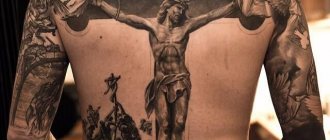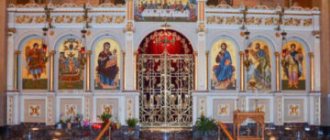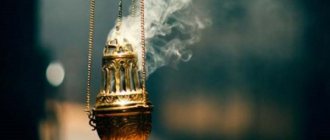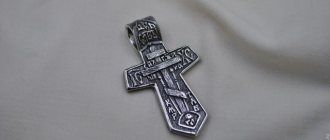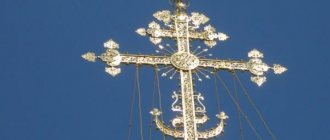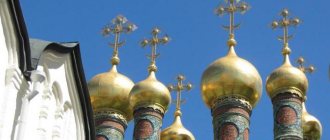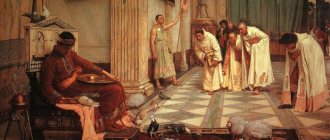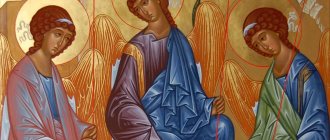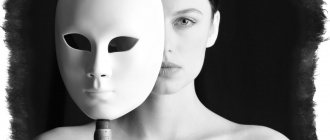If you ask any person, even those far from religion, what symbol comes to mind when they hear the word “Christianity,” he will answer: “cross.” But if he talks about the difference between intra-confessional movements, he will probably experience serious difficulties.
What can I say: few people who call themselves Orthodox will be able to identify a cross that corresponds to the church structure. Well, not all Christians come to church as devout believers and versed in the nuances of theology - many are baptized only following fashion.
However, each of us has freedom of conscience and is free to choose our own path to God. And we will help you take a small step towards him and tell you about the rules for choosing a pectoral cross.
The most important thing: the correct Orthodox cross must be consecrated in the church and personify faith in the feat of Jesus. Everything else is small nuances, of little significance to a true believer!
What an Orthodox cross should look like
So, an Orthodox pectoral cross should look like... Wait, it shouldn’t do anything: it’s a material symbol of faith that can take different forms. Yes, there are some canons, but they are so vague and conditional that it is almost impossible to make a mistake when choosing an Orthodox creed!
Church ministers are increasingly refusing to consecrate crosses due to non-compliance with the canons. The most advanced priests even consecrate crosses with Latin inscriptions and other signs of Catholic origin.
Contrary to popular misconception, the Orthodox Church recognizes crosses in a variety of shapes:
- Four-pointed. These simple crosses, consisting of just two crossed crossbars, are often called Latin crosses. Many people clearly consider them Catholic. This is incorrect: the Orthodox Church is not so categorical on this issue, especially since the baptist of Rus', Prince Vladimir, owned exactly such a cross. And one more thing: you can wear an Orthodox cross without a crucifix, inscriptions and other symbolic elements. Just a smooth four-pointed cross is enough!
View all gold “Cross” pendants in the SUNLIGHT catalog
- Six-pointed. In such crosses, another bar is added - an inclined lower one. There are different interpretations of its meaning: according to various sources, it symbolizes the internal balance of a person, his path to spirituality, or the scales on which human sins and blessings are weighed.
- Eight-pointed. These are canonical Orthodox crosses. Compared to six-pointed ones, they have an additional upper bar of shorter length than the main transverse one. It is called a title and serves as a symbol of a tablet that was once nailed over the head of the crucified Lord. According to the Orthodox tradition, the letters IHCI are inscribed on it, which, when deciphered from the Church Slavonic abbreviation, gives the phrase “Jesus of Nazareth, King of the Jews.” Since the time of Ivan the Terrible, this cross has been decorating the domes of churches, it is placed on the graves of parishioners of the Russian Orthodox Church, and is used in state symbols.
The eight-pointed cross is one of the oldest symbols of the Christian religion. It was widely used back in VI, when there were no Catholics, Orthodox, Uniates, Protestants and others like them, but there were simply Christians, united in the faith.
The canonical Orthodox cross with the crucifixion of Jesus Christ is visually somewhat different from the Catholic one. Let's go over the main differences:
- Figure of Christ. In the Orthodox tradition, the crucifix is more optimistic and life-affirming. Christ is depicted as already risen, with open arms and a spiritual look. The Catholic Savior is as if caught in the stage of agony or already dead: he hangs helplessly on the cross, clearly suffering.
- Nuances. On Catholic crucifixes there is often a crown of thorns on the head of Christ; in Orthodoxy it is usually absent. And the most important thing, on which many theological copies were broken - the feet of Christ. In the Orthodox tradition, the Savior receives a nail per foot (four in total), according to the Catholic tradition - one nail for both feet. Sometimes Orthodox priests refuse to consecrate crosses, guided by this very sign. Does the fact that Jesus is nailed with three nails make him no longer the Savior of mankind?
- Inscriptions. We have already talked about one inscription (it flaunts on the title, that is, the upper crossbar, or simply at the top of the cross) - Church Slavonic IHCI or Russian INCI. On the Catholic cross, a similar abbreviation is written in Latin INRI. On both crosses there may be all sorts of additional symbols and decorative elements, but only on the Orthodox cross on the reverse side is written: “Save and Preserve.”
There are many less common varieties of the Christian symbol. For example, the monastic cross-Golgotha, complemented by steps, a skull and other symbols, crosses with wedge-shaped petals topped with lilies or drops.
Cross and Savior
The most important symbol is, of course, the cross itself.
The custom of wearing a cross arose only in the 4th century; before that, Christians wore medallions depicting a lamb - a sacrificial lamb, symbolizing the self-sacrifice of the Savior. There were also medallions depicting the crucifixion. The cross - the image of the instrument of death of the Savior - became a natural continuation of this tradition.
Initially there were no signs on the pectoral crosses, only floral ornaments. It symbolized the Tree of Life, which Adam lost and Jesus Christ returned to people.
In the 11th-13th centuries. on the crosses an image of the Savior appears, but not crucified, but seated on a throne. This emphasizes the image of Christ as the King of the Universe, to whom “all authority in Heaven and on Earth has been given.”
But even in earlier eras, crosses with the image of the crucified Savior occasionally appear. This had a special meaning in the context of the struggle against Monophysitism - the idea of the complete absorption of human nature in the person of Jesus Christ by the Divine nature. Under such conditions, the depiction of the Savior’s death emphasized his human nature. Ultimately, it was this image of the Savior on the pectoral cross that prevailed.
The head of the crucified man is surrounded by a halo - a symbol of holiness - with the inscription in Greek "UN", which means "The Existing One". This emphasizes the divine essence of the Savior.
How to choose a pectoral Orthodox cross
Often parents (blood or godparents) find it difficult to choose a symbol for the sacrament of baptism. The main rule applies here: the baptismal cross should be comfortable and safe for the child.
Here are the basic principles of selection:
- Deeply religious Orthodox Christians wear a cross with a crucifix, but as we found out, this is not necessary. For a child, it is better to choose a cross without protruding elements: with an engraved crucifix or without it at all.
- The cross should have rounded ends so that the baby's delicate skin is not scratched. For the same reason, it is better to abandon any inserts and additional decor.
- A Christian cross can be made of any material, but for kids it is better to choose silver options. This metal is not too expensive, and also has a pronounced antiseptic effect.
If you want to choose the right Orthodox cross on the neck for a deeply religious adult, take the canonical eight-pointed one. Crucifixion in this case is mandatory.
Since children are usually baptized at a very tender age, it is better to stop at the smallest cross and hang it not on a chain, but on a gaitan cord. In the first year of life, a child does not have to wear a cross: the mother can wear it in parallel with her own. The second option is to hang a symbol of faith near the baby’s crib.
Types of materials
Contrary to popular belief, the Orthodox Church does not have specific requirements for the material of the cross. It can be carved from wood (which is not very practical) or stone, cast from simple metal or jewelry alloy.
The spiritual content of a symbol of faith does not depend in any way on the material from which it is made. True, most people prefer to choose crosses made of precious materials: they are not only more aesthetically pleasing, but also practical (durable, practically do not cause allergic reactions).
Gold pendant with cubic zirconia (go to the SUNLIGHT catalogue)
The Church considers pride and love of money to be mortal sins. Therefore, even if you choose a very expensive platinum cross with diamonds, you need to wear it under clothes.
Source of the article: link Varieties of the cross
“The cross of any form is the true cross,” taught the Monk Theodore the Studite back in the 9th century. And in our time it happens that in churches they refuse to accept notes with four-pointed “Greek” crosses, forcing them to correct them to eight-pointed “Orthodox” ones. Is there one, “correct” cross? To help figure this out, we asked the head of the MDA icon painting school, associate professor, abbot LUKU (Golovkova) and leading specialist in staurography, candidate of art history Svetlana GNUTOVA.
What was the cross on which Christ was crucified?
“ The Cross is a symbol of the Suffering of Christ, and not only a symbol, but an instrument through which the Lord saved us,” says Abbot Luka (Golovkov) . “Therefore, the Cross is the greatest shrine through which God’s help is accomplished.”
The history of this Christian symbol began with the fact that the holy Queen Helen in 326 found the Cross on which Christ was crucified. However, what exactly he looked like is now unknown. Only two separate crossbars were found, along with a sign and a footstool. There were no grooves or holes on the crossbars, so there is no way to determine how they were attached to each other. “There is an opinion that this cross could have been in the shape of the letter “T,” that is, three-pointed,” says leading specialist in staurography, candidate of art history Svetlana Gnutova . - The Romans at that time had the practice of crucifying people on such crosses, but this does not mean that the Cross of Christ was exactly like that. It could be four-pointed or eight-pointed.”
The debate about the “correct” cross did not arise today. The debate about which cross was correct, eight-pointed or four-pointed, was waged by Orthodox and Old Believers, with the latter calling a simple four-pointed cross “the seal of the Antichrist.” Saint John of Kronstadt spoke in defense of the four-pointed cross, devoting his candidate’s dissertation to this topic (he defended it in 1855 at St. Petersburg Academy of Sciences) “On the Cross of Christ, in denunciation of imaginary Old Believers”: “Who does not know and does not honor the Holy Cross with four ends from the elder and until the boy? And this well-known form of the cross, this most ancient shrine of faith, the seal of all the sacraments, like something new, unknown to our ancestors, appeared yesterday, our imaginary Old Believers suspected, disparaged, trampled underfoot in broad daylight, spewing blasphemies that from the very the beginning of Christianity and has until now served and continues to serve as a source of sanctification and salvation for everyone. Respecting only the eight-pointed or three-part cross, that is, a straight shaft and three diameters on it, located in a known way, they call the so-called four-pointed cross, which is the true and most common form of the cross, the seal of the Antichrist and the abomination of desolation!
St. John of Kronstadt explains: “The “Byzantine” four-pointed cross is in fact a “Russian” cross, since, according to Church Tradition, the holy Equal-to-the-Apostles Prince Vladimir brought from Korsun, where he was baptized, just such a cross and was the first to install it on the banks of the Dnieper in Kyiv. A similar four-pointed cross has been preserved in the Kiev St. Sophia Cathedral, carved on the marble plaque of the tomb of Prince Yaroslav the Wise, son of St. Vladimir.” But, defending the four-pointed cross, St. John concludes that both should be venerated equally, since the shape of the cross itself has no fundamental difference for believers. Hegumen Luke: “In the Orthodox Church, its holiness does not depend in any way on the shape of the cross, provided that the cross is made and consecrated precisely as a Christian symbol, and not originally made as a sign, for example, of the sun or part of a household ornament or decoration. This is why the rite of consecration of crosses became obligatory in the Russian Church, just like icons. It’s interesting that, for example, in Greece, the consecration of icons and crosses is not necessary, because Christian traditions in society are more stable.”
Why don't we wear the sign of fish?
Until the 4th century, while the persecution of Christians continued, it was impossible to openly make images of the cross (including so that the persecutors would not abuse it), so the first Christians came up with ways to encrypt the cross. That is why the very first Christian symbol was the fish. In Greek, "fish" is Ίχθύς - an acronym for the Greek phrase "Iησοvς Χριστoς Θεov Υιoς Σωτήρ" - "Jesus Christ God's Son the Savior." The image of two fish on either side of a vertical anchor topped with a cross was used as a secret “password” for Christian meetings. “But the fish did not become the same symbol of Christianity as the cross,” explains Abbot Luke, “because the fish is an allegory, an allegory. The Holy Fathers at the Fifth-Sixth Trullo Ecumenical Council of 691-692 directly condemned and prohibited allegories, since this is a kind of “educational” image that only leads to Christ, in contrast to the direct image of Christ himself - our Savior and the Cross of Christ - the symbol of His Passion . Allegories disappeared from the practice of the Orthodox Church for a long time and only ten centuries later they began to re-enter the East under the influence of the Catholic West.”
The first encrypted images of the cross itself were found in Roman catacombs of the 2nd and 3rd centuries. Researchers found that the tombs of Christians who suffered for their faith often featured a palm branch as a symbol of eternity, a brazier as a symbol of martyrdom (this is the method of execution that was common in the first centuries) and a Christogram - an abbreviation of the name Christ - or a monogram consisting of the first and the last letters of the Greek alphabet Α and Ω - according to the word of the Lord in Revelation to John the Theologian: “I am Alpha and Omega, the beginning and the end” (Rev. 1, 8). Sometimes these symbols were drawn together and arranged in such a way that the image of a cross was guessed in them.
When did the first “legal” cross appear?
To the Holy Equal-to-the-Apostles King Constantine (IV), “Christ, the Son of God, appeared in a dream with a sign seen in heaven and commanded, having made a banner similar to this seen in heaven, to use it for protection from the attacks of enemies,” writes church historian Eusebius Pamphilus. “We happened to see this banner with our own eyes.” It had the following appearance: on a long spear covered with gold there was a transverse yard, which with the spear formed the sign of a cross, and on it the first two letters of the name Christ, combined together.”
The king wore these letters, later called the monogram of Constantine, on his helmet. After the miraculous appearance of St. Constantine ordered images of the cross to be made on the shields of his soldiers and installed three memorial crosses in Constantinople with the gold inscription in Greek “IC.XP.NIKA”, which means “Jesus Christ the Victor”. He installed the first cross with the inscription “Jesus” on the triumphal gates of the city square, the second with the inscription “Christ” on a Roman column, and the third with the inscription “Winner” on a high marble pillar in the city’s bread square. From this began the universal veneration of the Cross of Christ.
“Holy images were everywhere so that, more often visible, they would encourage us to love the Prototype,” explains Abbot Luke. “After all, everything that surrounds us affects us in one way or another, good and bad. A holy reminder of the Lord helps the soul to direct its thoughts and hearts to God.”
From how St. wrote about these times. John Chrysostom: “The cross is everywhere in glory: on houses, in the square, in solitude, on roads, on mountains, on hills, on plains, on the sea, on ship masts, on islands, on couches, on clothes, on weapons, at feasts, on silver and gold vessels, on precious stones, on wall paintings... so everyone vied with each other to admire this amazing gift.”
It is interesting that since the opportunity to legally make images of the cross arose in the Christian world, encrypted inscriptions and Christograms have not disappeared, but have migrated, as an addition, to the crosses themselves. This tradition also came to Russia. Since the 11th century, under the lower oblique crossbar of the eight-pointed crucifixion, which was installed in churches, a symbolic image of the head of Adam, buried, according to legend, on Golgotha, appears. The inscriptions are a brief commentary on the circumstances of the Lord’s crucifixion, the meaning of His death on the cross and are deciphered as follows: “M.L.R.B.” - “the place of execution was quickly crucified”, “G.G.” - “Mount Golgotha”, The letters “K” and “T” mean a copy of a warrior and a cane with a sponge, depicted along the cross. Above the middle crossbar are the inscriptions: “IC” “XC”, and below it: “NIKA” - “Winner”; on the sign or next to it there is the inscription: “SN BZHIY” - “Son of God”, “I.N.Ts.I” - “Jesus the Nazarene King of the Jews”; Above the sign is the inscription: “TSR SLVY” - “King of Glory.” "G.A." - “head of Adam”; Moreover, the bones of the hands lying in front of the head are depicted: right on left, as during burial or communion.
Catholic or Orthodox Crucifix?
“The Catholic Crucifixion is often written more naturalistically,” says Svetlana Gnutova. — The Savior is depicted hanging in his arms, the image conveys the martyrdom and death of Christ. In ancient Russian images, Christ is depicted as Risen and Reigning. Christ is depicted in power - as a conqueror, holding and calling the entire Universe into His arms.”
In the 16th century, the Moscow clerk Ivan Mikhailovich Viskovaty even spoke out against crosses, where Christ is depicted on the cross with his palms clenched into a fist, rather than open. “Christ on the cross stretched out his arms to gather us,” explains Abbot Luke, “so that we would strive towards heaven, so that our aspiration would always be towards the heavenly. Therefore, the cross is also a symbol of gathering us together, so that we are one with the Lord!”
Another difference between the Catholic Crucifixion is that Christ is Crucified with three nails, that is, the nails are driven into both hands, and the soles of the feet are put together and nailed with one nail. In the Orthodox Crucifixion, each foot of the Savior is nailed separately with its own nail. Abbot Luke: “This is a fairly ancient tradition. In the 13th century, custom-made icons were painted in Sinai for the Latins, where Christ was already nailed with three nails, and in the 15th century such Crucifixions became the generally accepted Latin norm. However, this is only a tribute to tradition, which we must respect and preserve, but not look for any theological implications here. In the Sinai Monastery, icons of the Lord Crucified with three nails are in the temple and are revered on a par with Orthodox crucifixes.”
Cross - Love crucified
“The iconography of the cross develops like any other iconography. The cross can be decorated with ornaments or stones, but in no way can it become 12-pointed or 16-pointed,” says Svetlana Gnutova. “The variety of forms of the cross in the Christian tradition is the variety of glorification of the Cross, and not changes in its meaning,” explains Abbot Luke. - Hymnographers glorified the Cross with many prayers, just as icon painters glorify the Cross of the Lord in different ways. For example, an image of a tsata appeared in icon painting - a royal or princely pendant in the shape of a crescent; in our country it is usually used on icons of the Mother of God and Christ; it soon appeared on the cross to emphasize its royal significance.
Of course, we need to use crosses that are written in the Orthodox tradition. After all, the cross on the chest is not only a help to which we resort in prayers, but also a testimony of our faith. Although, I think we can accept images of crosses of ancient Christian denominations (for example, Copts or Armenians). Catholic crosses, which after the Renaissance became too naturalistic in form, do not coincide with the Orthodox understanding of Christ Crucified as the Victor, but since this is an image of Christ, we should treat them with reverence.”
As St. wrote. John of Kronstadt: “The main thing that should remain in the Cross is Love: “The Cross without love cannot be thought of or imagined: where the cross is, there is love; in church you see crosses everywhere and on everything so that everything reminds you that you are in the temple of Love crucified for us.”
What does the skull on the cross mean?
It would seem that before us is a symbol of salvation and the triumph of life, so why is a skull and crossbones sometimes depicted below on a cross? This cannot be some kind of mystical symbol, because the Christian Church has a negative attitude towards occult knowledge.
Some people associate this image with a reminder of the frailty of earthly life. But there is a better version. According to legend, it was on Golgotha, where Christ suffered martyrdom, that the remains of the first man, Adam, rest. And the blood of the Savior washed the land of the Place of Execution, at the same time washing away the sins of human ancestors.
What does the inscription NIKA on the cross mean?
Any educated person will say that “Nika” translated from Greek means “victory.” That, by the way, was the name of the ancient Greek goddess of victory, a close relative of the ancient Roman Victoria. So why is the name of a pagan goddess often emblazoned on Orthodox crosses?
So, the word NIKA on the cross means “victory.” According to historical chronicles, crosses with the initials of the Savior and the word “Nike” were installed in Byzantium by Emperor Constantine. This was done in honor of the victory over the Roman emperor Marcus Aurelius and marked the triumph of the new faith. Now this inscription is interpreted more simply: the Savior atoned for human sins and conquered death itself.
The main thing in an Orthodox cross is not its shape or market value, but its spiritual content. And they are endowed with symbols of faith exclusively by the people who wear and venerate them!
06.04.21
